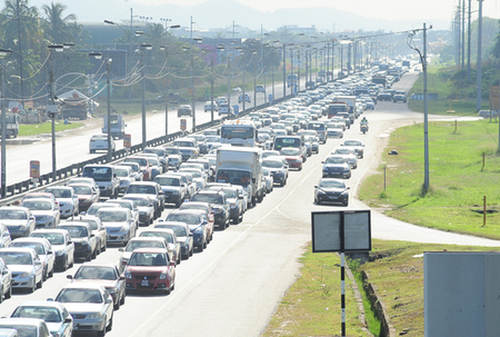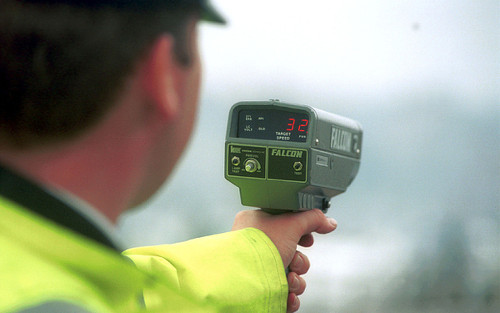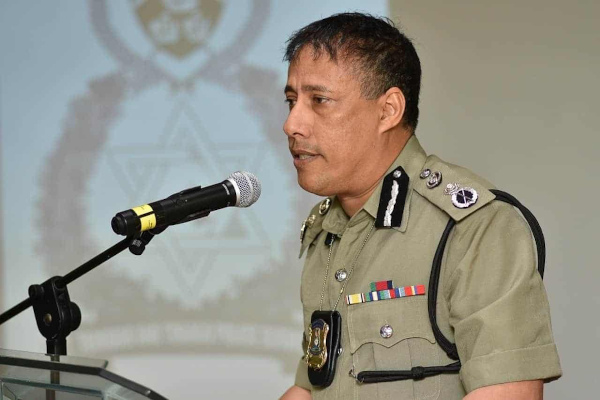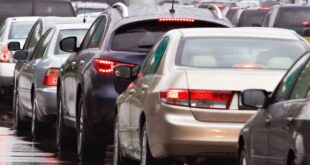The following blog on life for commuters in Trinidad was submitted to Wired868 by Jeremy Francis:
I recently had a client meeting in the East, so I was on my way up the highway. This was before the introduction of the speed guns. The meeting was at 9 am, so being as punctual I always try to be, I was parked outside their office by 8:15 am. In order to do that, I had to leave Port of Spain just a little after 7 am.
If I didn’t do that, I’d get stuck in traffic and, eventually, be late. I used my time well by typing this article.

(Courtesy Nation News)
Once you are a driver in Trinidad, you know that it’s either you are early or late—for a meeting or for work. There is no in-between, really. The speed guns have only made this worse.
As I was driving along the highway, I looked at the time. At 8 am there was bumper-to-bumper traffic all the way into Port of Spain. Past experience tells me this might start all the way down in Chaguanas; sometimes as far as Couva. We all know the stress of traffic and the impact it has on productivity.
The fact that these drivers were still in their cars at 8 am made one thing obvious—they were all late for work. And though every day is different, one thing is constant; there are always hundreds (even thousands) of people, streaming into their offices after the appointed start time.
But does it really matter? Of course it does. Productivity is affected. Or is it?
Most of the companies I deal with complain about tardiness and absenteeism. Quite a lot. Many of them have chonic problems in those areas. In many cases, traffic is the main excuse, because quite frankly, it is a very serious problem.

(Copyright UK Telegraph)
But there is something else that causes lateness or no-shows: apathy. There are people who just don’t enjoy their jobs and aren’t motivated to struggle with the other drivers to get to work on time.
Another issue relates to time. When I lived in the East, our family had to leave home by 5:15 am to beat the traffic. This meant that the kids were at the daycare by 6:30 am and my wife and I were at work well before starting time.
Sounds good, except that we had to get up at 4:00 am every morning, after getting home after 7:00 pm each night, because of (guess what) traffic. Some families have to leave home even earlier.
So the issue comes down to when we start work. Whether it is 8:00 am, 8:30 am or 9:00 am, some employees will be late. Even some of those who are highly motivated and effective. So what then, is the solution?
One of them isn’t telecommuting. As I mentioned in another article, this involves a high level of maturity, a robust work ethic and a well developed Performance Management System. Some employees can function well in this environment, but others will get distracted at home. As someone who has done this for years, I know of what I speak.

The simpler and more realistic solution to this is decentralisation. In the mid 2000’s when the price of oil and gas was high, the then government went on a building spree constructing a number of high-rise government offices in the capital city. Even back then I knew this was a mistake.
The fact that many of these offices are still empty today is testament to the fact that you can’t build your way to developed world status.
What the government should have done—and should still do—is set up a number of micro-offices in communities across the island.
All that is required is to set up a number of shared-services units in community centres and satellite offices staffed by public officers from the community (or close to it), where citizens can access vital services without having to traverse too far.
The impact is simple: public officers, who are represent a considerable portion of working population, would set up shop closer to home, checking in to main office on a staggered schedule. They could spend two or three days in their communities, dispensing services they normally would from the main office.

The public would now have the option of accessing these services closer to home, thereby reducing the need to be on the roads as much. This reduces traffic and the dependence on gas right away and has an immediate impact on the environment.
It will also have an impact of work-life balance, by giving many people back many hours of their day. And for those who still have to travel long distances, the burden is reduced, because there are fewer cars on the road.
For this to work effectively, the process and procedures of many government offices will have to be looked at and re-vamped. Work will have to be done differently. But when the pay-off is less time on the roads—and the ability to work closer to home—who would object? Possibly the unions. But that is a story for another time.
Might a programme like this actually work?
Want to share your thoughts with Wired868? Email us at editor@wired868.com.
Please keep your letter between 300 to 600 words and be sure to read it over first for typos and punctuation.
We don’t publish anonymously unless there is a good reason, such as an obvious threat of harassment or job loss.
 Wired868 Wired868 for smart sport news and opinion
Wired868 Wired868 for smart sport news and opinion







New police cars seem to get old really quickly!
We need to investigate the system in place to maintain those vehicles.
Why can’t we schedule buses to run on all of the routes on time and with some regularity (e.g. at least hourly in every area) with effective maintenance to keep the buses operating? If we look at the TTPS, we probably have more cars down and out than on the road. Why is it so difficult for State vehicles to be regularly and properly maintained? I put forward one reason – the drivers of those vehicles who do not care.
Our leaders were so forward thinking when they closed down the British train network.
..scaled down rail system…
Remove the diesel subsidy fully
Build more interchanges
Put an actual bus system into place
One of the factors compounding the traffic situation is unnecessary vehicle use. Many folk could use public transport but won’t. Another factor is T&T’s failure to embrace the carpool concept. Etc
Kenneth, the public transport system is unable to cope even with most people choosing to drive now. There is no choice.
I live in Arima. My work takes me regularly to Couva, Marabella and Port of Spain.
Do you know how many taxis I would have take and what my waiting time in queues would be to get there?
It feels like a kick in the groin to not acknowledge how difficult it is to move around here.
Years ago I had so many ideas, now you think who really cares
Lasana Liburd my first job was on shift in Couva, I lived in Trincity so I had to take 2 taxis and a maxi and a 10 minute walk to get to and from work. There was sometimes a 10/15 minute wait between available taxi/maxi.
We need to get a more efficient way to move people around the country
I hear that Nigel. Now consider that I’m covering games that are finishing at 9.30 pm or 10 pm. What choice do I have?
I’m certain that this is part of the reason for the fall in attendances. You have to own a car to watch a match outside your corridor. And that seems ridiculous for such a small country.
I understand, Lasana! Hence my statement initially that mass transit needs to be launched yesterday and major thoroughfares need to be redesigned with input from citizens and experts to ease the pain. Note also, for this to be successful one of our major hurdles must aggressively be curtailed… CORRUPTION
There are very simple solutions available
Let me take a read at the article though
I don’t understand what the speed gun has to do with the traffic in the morning in bumper to bumper traffic. While I agree in principle with telecommuting, I don’t think that there are that many jobs in T&T now that would allow this. Decentralisation is probably the way to start even though I have been hearing about that since Eric was PM!
It doesn’t have anything to do with the traffic, but if you are heading to south from POS for a meeting or work as an example, you have to leave earlier than usual, spending a longer period on the road. Safer to drive within the limit, just a longer commute.
They have shown time differences somewhere and to San F’do, I do not recall the time being even 1/2 hour more. The current speed limit will be increased in time so that will not be an issue (even now).
In most households everyone has a car! The truth is we talk mass transit but I believe most people won’t leave their car home.
Everyone has a car becuase there is no reliable alternative. Fix that and people will leave them home. Especially when the gas subsidy is totally removed
I would love to leave mine home. It is very productive when you can gather your thoughts comfortably on the way to work. I did some of my best writings on the train when you have solitude for a few hours.
Like those trains with comfy lounge seats that have breakfast on sale ! The problem is most people like freedom to “pick up & leave”
I think if you know bus times and travel time, a lot of people will take that security. I would many times.
I have taken the bus from Arima to POS at 7 am and unless the plan remove those maxis and take away buss passes you really can’t make it to work on time
They promised us a mass transit system
But people complain
Traffic was the single most contributing factor to why I left my last permanent job. It’s a rat race out there
I see parents as early as 5 am with children fully dressed for school.
Some are left on the school compound at 6am for mom to get to work on time and picked up at 5/6pm in the evening as mom has to face traffic again in the evening. I really feel sorry for these kids
By 11am that child cant focus on anything .
I’ve heard the stories from my friends at my last job..those kids fall asleep in their dinner plates and still has homework to do!
I travel from east to central and from Arima at 5am I am seeing parents with children fully dressed coming in the maxi .
Not good at all… Wow…
A happy workforce is a productive one , full stop .
A happy workforce is a productive one, full stop .
Decentralisation and flexi-time is the way to go. That way the general public will have access to services for a longer period during the day and everyone wouldn’t be rushing in for 8am
This is so true . The traffic and job satisfaction does play a great deal in punctuality . A defensive driving instructor once told us that either BP or BG has a room at their POS office with a water fountain , scented candles and soft music for employees coming from long distances to sit in before taking up duties ..
Yup…we are quick to complain about service, but many commute from south to POS daily, leave home before the crack of dawn and reach home after sunset. By the time u get to wk u feel like u already make a day’s work. We ignore the impact on health with increasing heart disease and diabetes and also on family life. Can u tell me realistically why we expect productivity under these conditions? How many productive hours do we get out of our employees? Is it time for our work culture to be flexible?
Commuting in T&T is deplorable, I agree, and definitely not conducive to safe driving, employee productivity, student effectiveness and ease of public & commercial transportation. Contrarily, the speed gun program implementation did not make ‘things’ worse! It is having a positive impact on driving safely. The roadways must be redesigned, work must be redeployed throughout the nation to reduce commute load into Port of Spain, San Fernando, and Scarborough and a national mass transit solution must be identified, adopted and implemented.
Lasana Liburd you made an earlier comment about only 4 countries in the world have a speed limit slower than Trinidad (thus my comment about comparing apples with apples)
I hold no grief for Minister Hinds (or the PNM) but whilst I agree that there are sections of our highways which could have an increased speed limit, i do not support a wholesale increase
It is fine to have different speed limits for different major roads. But what part of the highway you think should be slower Nigel?
Trini drivers love to speed! Hopefully, those MPs who were charged with transportation infrastructure will identify some solutions. I’m pleased they, TTPS, implemented the speed gun program. I hope they continue to enforce the law because some drivers are still speeding.
Nah. I disagree on the speed limit. I think a 1979 speed limit is stupid in 2016. I can go on and on about the changes in our roads since then and automobile technology.
But I guess we have all chosen our camps already where that is concerned.
There are only four countries in the world with a maximum speed limit on the highway that is as slow as ours btw: Bhutan, Macau, Curacao and Suriname.
But what can I say yes.
And on the other side, all the countries with higher speed limits have better mass transit systems, better roads, wider roads, better law enforcement, less cars per person ratio, and many other factors.
You cannot bring an argument unless all factors are equal.
All the other countries in the world but those four Jumbie? Thankfully, I’ve travelled quite a bit and know that isn’t true.
Paula Trini Ayoung It’s all about speed, nothing else. Many have failed to realize that speed gets you no where fast but 6 feet under. So regardless, of all the improvements made and will be made, speed guns implementation, even when and if the speed limit is raised and mass transit is launched there will be speedsters. The key to this problem is not speed but the probable solutions I mentioned above.
Lasana Liburd there are highways and then there are highways. Our highways have areas where peoples driveways lead directly unto the highway. I think for reasons similar to those comparing highways in Trinidad to other countries may not be apple to apple.
But as you said, we are already in our camps
No Nigel Noel, the speed limit was built when Trinidad and Tobago was a single carriageway. And cars had none of the modern technology you know.
So it makes no sense that technology has made our vehicles unrecognisable to 1979 models and a thousand times safer, yet we still are asked to drive at 1979 speed.
So I am not even comparing it to overseas roads Nigel. I’m comparing it to Trinidad roads in 1979.
Apart from the fact that Dr Rae Furlonge, Traffic and Transport engineer, called the current speed law ridiculous.
http://www.cnc3.co.tt/news/traffic-expert-speed-limit
But what I say. Fitzgerald Hinds knows best as far as some are concerned.
Kenneth H. Ransome Jr., there is no such thing as speeding really. It is about driving for road conditions. Germany doesn’t even have a speed limit.
If the road is wet and someone drive at 80 kph, they would be a fool. That would be too fast.
For me, it is simple logic that if Trinidad engineers decided in 1979 that people could drive safely at 80 kph on what passed for a highway then… Then those same engineers would not come up with 80 kph now.
I think that is simple logic personally. And Dr Rae Furlonge, Traffic and Transport engineer, agrees with me.
On the Uriah Butler from Grand Bazaar to Chaguanas there are numerous locations where minor roads and driveways lead directly to highway so in my opinion the speed limit should remain at 80 Kph (from Chaguanas going south could be increased at about 120kph)
On the CRH between Grand Bazaar and POS it could be increased to about 120 kph (as there are no lights).
On the CRH where there are 3 lanes but numerous traffic lights the speed limit could be increased to 100 Kph but where there are only 2 lanes 80 Kph should be maintained.
Nigel Noel, I can see some logic in that. Call Fitzie!
Lasana Liburd unlike some other former saints men, i dont have a direct link to Fitzie or Keithos…….but I think the “junior minister of everything” go remember who I am……….?
Lol
check this…..there are a lot of parallels. https://www.youtube.com/watch?v=0yAIOgYlrwU
I’m not reading this because I remember how upset people were when traffic was eliminated in St. James a few years ago.
You and your one-man crusade against information! Hahaha
More like a one man crusade against futility.
Hahaha. Touche. Come chase unicorns with us Vernal. Don’t be like that. 🙂
Not a snail race?
Jeremy,
There is a lot of merit in what you propose but it is a rather simplistic view of the reality. Decentralisation must involve decentralisation in place but that is only one aspect of a very complex problem. There are deeply ingrained cultural and political habits – you give them very short shrift in your piece – that actively work against the success of any attempt to change the status quo.
What that effectively means is that, without a large-scale public education programme, decentralisation cannot succeed – as Franklin Khan is, I predict, certain to find out when he gets around to attempting to implement even the (largely cosmetic) changes the existence of his ministry makes mandatory.